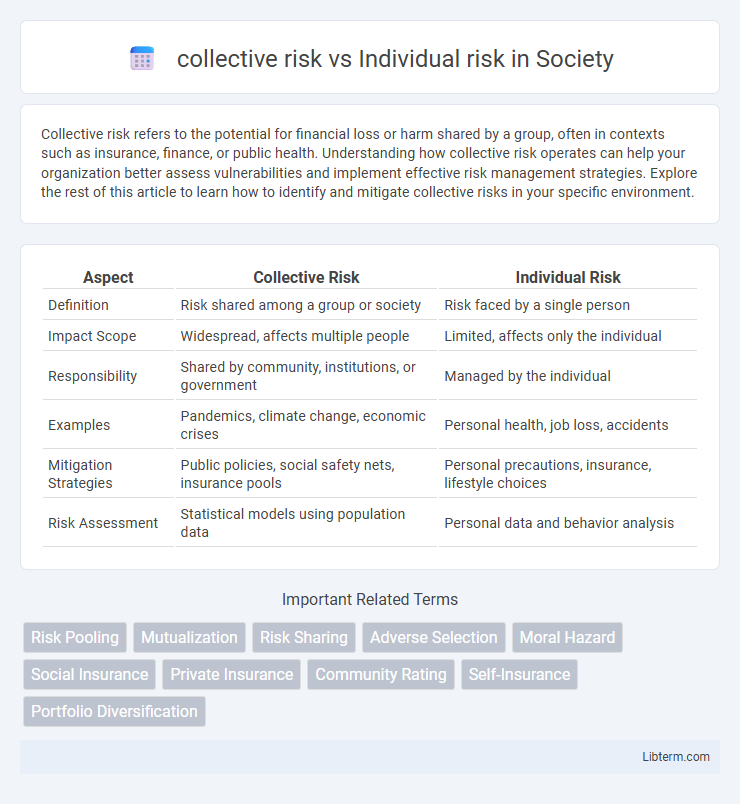Collective risk refers to the potential for financial loss or harm shared by a group, often in contexts such as insurance, finance, or public health. Understanding how collective risk operates can help your organization better assess vulnerabilities and implement effective risk management strategies. Explore the rest of this article to learn how to identify and mitigate collective risks in your specific environment.
Table of Comparison
| Aspect | Collective Risk | Individual Risk |
|---|---|---|
| Definition | Risk shared among a group or society | Risk faced by a single person |
| Impact Scope | Widespread, affects multiple people | Limited, affects only the individual |
| Responsibility | Shared by community, institutions, or government | Managed by the individual |
| Examples | Pandemics, climate change, economic crises | Personal health, job loss, accidents |
| Mitigation Strategies | Public policies, social safety nets, insurance pools | Personal precautions, insurance, lifestyle choices |
| Risk Assessment | Statistical models using population data | Personal data and behavior analysis |
Understanding Collective Risk and Individual Risk
Understanding collective risk involves assessing the probability and impact of adverse events affecting a group, organization, or population, where the consequences extend beyond individuals to the larger system. Individual risk focuses on the likelihood and severity of harm to a single person based on personal exposure and vulnerability factors. Evaluating both collective and individual risks enables comprehensive risk management strategies that address systemic threats and protect individual safety.
Key Differences Between Collective and Individual Risk
Collective risk involves the probability of loss or damage shared among a group, often used in contexts like insurance pools or public health, reflecting aggregate outcomes rather than specific individual events. Individual risk pertains to the likelihood of a particular event affecting a single person or entity, measured based on personal exposure or behavior. Key differences include scale, as collective risk assesses combined potential losses across multiple individuals, whereas individual risk focuses on singular impact, and management strategies, which vary from group-based mitigation to personalized risk controls.
Historical Perspectives on Risk Management
Historical perspectives on risk management reveal that collective risk approaches emerged prominently during the Industrial Revolution, where shared risks in factory settings led to the development of early insurance systems and worker protection laws. Individual risk management traditionally focused on personal decisions and responsibilities, but large-scale disasters such as the 1918 influenza pandemic highlighted the limitations of isolated efforts. Over time, risk management evolved to balance individual accountability with collective safeguards, emphasizing systemic resilience and public health frameworks.
Examples of Collective Risk in Society
Collective risk refers to the potential harm or loss experienced by a group or community due to shared exposures, such as natural disasters like hurricanes or pandemics like COVID-19, which affect entire populations. Environmental pollution causing widespread health issues and economic recessions impacting unemployment rates also exemplify collective risk. These scenarios highlight how vulnerabilities and threats extend beyond individuals, requiring coordinated societal responses and risk management strategies.
Individual Risk: Personal Choices and Responsibilities
Individual risk centers on personal choices, emphasizing how behavior, lifestyle, and decision-making directly influence health outcomes and safety. Factors such as smoking, diet, exercise, and adherence to safety protocols shape the likelihood of adverse events at the individual level. Understanding personal responsibilities helps mitigate hazards by promoting risk awareness, preventive actions, and informed decision-making tailored to specific vulnerabilities.
Collective Risk in Public Health and Safety
Collective risk in public health and safety refers to the shared potential for harm affecting entire populations due to environmental hazards, infectious diseases, or systemic failures. Managing collective risk involves strategies like vaccination programs, pollution control, and disaster preparedness to mitigate widespread impacts. Understanding collective risk is crucial for developing policies that protect community well-being and reduce health disparities.
Financial Implications: Shared vs. Personal Risk
Collective risk disperses financial burden across a group, reducing individual liability and enhancing risk management efficiency in organizations or communities. Individual risk places full financial responsibility on a single person, often leading to higher personal losses and limited recovery options. Businesses and insurers prefer collective risk models to stabilize financial outcomes and optimize capital allocation.
Policy Approaches to Managing Risk
Policy approaches to managing collective risk emphasize systemic resilience and social safety nets, such as public health programs and disaster relief funds, to mitigate widespread impacts. In contrast, individual risk management policies prioritize personalized measures like insurance, risk assessments, and incentivizing proactive behaviors to reduce personal exposure. Both approaches require integrated frameworks that balance shared responsibility with individual accountability to enhance overall risk mitigation effectiveness.
The Role of Community in Mitigating Collective Risk
Community engagement plays a critical role in mitigating collective risk by fostering shared responsibility and promoting cooperative strategies such as neighborhood watch programs and communal disaster preparedness plans. Collective risk management benefits from leveraging diverse local knowledge and resource pooling, enhancing resilience against widespread threats like pandemics, natural disasters, and economic downturns. Emphasizing social cohesion and effective communication networks enables communities to respond swiftly and reduce vulnerability for all members.
Balancing Individual Freedom with Shared Responsibility
Balancing individual freedom with shared responsibility requires understanding collective risk as the potential harm to a group arising from individual actions, whereas individual risk pertains solely to personal exposure. Effective risk management strategies emphasize promoting social behaviors that reduce collective hazards without unnecessarily restricting personal liberties. Policies rooted in transparent communication and public engagement foster cooperative efforts to mitigate risks while respecting individual rights and choices.
collective risk Infographic

 libterm.com
libterm.com